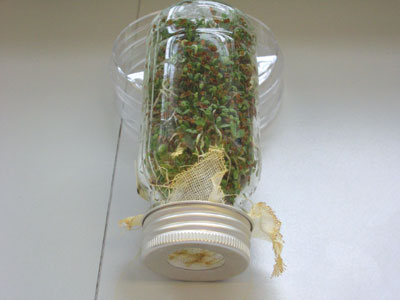 Transconjugation in a plant system.
It is widely recognised that antibiotic resistance and in particular multi-antibiotic resistance among food borne bacteria is a rapidly increasing problem. Multi-drug resistant
Salmonella
Typhimurium DT104 have emerged as a global health problem over the last decade and typically express resistance to ampicillin, chloram-phenicol, streptomycin, sulfonamides and tetracycline (ACSSuT). Such multi-drug resistant (MDR) S. Typhimurium DT104 are of particular concern in immuno-comprised patients as it restricts clinical options in the treatment of salmonellosis. In more general terms, it has potential consequences in relation to transfer and dissemination of antibiotic resistance to other pathogens. The genes encoding b-lactamases, which form the predominant agents of ampicillin resistance in gram-negative bacteria are widely distributed in
Salmonella
spp. and are frequently associated with the above (ACSSuT) resistance profile. Research at Ashtown Food Research Centre investigated the transfer of b-lactam antibiotic resistance genes from a donor S. Typhimurium DT104 strain to recipient strains,
E. coli
K12 and
S. Agona
in food systems (milk and beef). Transfer of antibiotic transfer was observed to occur in both matrices and molecular analysis by PCR (polymerase chain reaction) showed the presence of the �-lactamase genes
carb
and
tem
in the
E. coli
K12 transconjugant confirming the huge potential for antibiotic resistance to disseminate widely among food borne bacteria.
Transconjugation in a plant system.
It is widely recognised that antibiotic resistance and in particular multi-antibiotic resistance among food borne bacteria is a rapidly increasing problem. Multi-drug resistant
Salmonella
Typhimurium DT104 have emerged as a global health problem over the last decade and typically express resistance to ampicillin, chloram-phenicol, streptomycin, sulfonamides and tetracycline (ACSSuT). Such multi-drug resistant (MDR) S. Typhimurium DT104 are of particular concern in immuno-comprised patients as it restricts clinical options in the treatment of salmonellosis. In more general terms, it has potential consequences in relation to transfer and dissemination of antibiotic resistance to other pathogens. The genes encoding b-lactamases, which form the predominant agents of ampicillin resistance in gram-negative bacteria are widely distributed in
Salmonella
spp. and are frequently associated with the above (ACSSuT) resistance profile. Research at Ashtown Food Research Centre investigated the transfer of b-lactam antibiotic resistance genes from a donor S. Typhimurium DT104 strain to recipient strains,
E. coli
K12 and
S. Agona
in food systems (milk and beef). Transfer of antibiotic transfer was observed to occur in both matrices and molecular analysis by PCR (polymerase chain reaction) showed the presence of the �-lactamase genes
carb
and
tem
in the
E. coli
K12 transconjugant confirming the huge potential for antibiotic resistance to disseminate widely among food borne bacteria.
Indeed is not only pathogens which are a concern in terms of dissemination of antibiotic resistance and research is also being undertaken on the role of naturally occurring lactic acid bacteria (LAB) in the spread of antibiotic resistance. Transconjugation studies (transfer of antibiotic resistance from one organism to another when present in the same environment) have been undertaken in an animal model (rumen fluid) and a plant model (alfalfa sprouts). Transfer of the antibiotic resistant genes between the organisms was shown to occur in both model systems. Research is continuing on the transfer of antibiotic resistance from LAB to LAB and from LAB to bacterial pathogens such as
Salmonella
, with and without selective pressure. This research indicates future food safety implications for the fermented foods industry with strain selection needing to consider the presence of genetic determinants of antibiotic resistance and to characterise these in terms of potential transfer.
Contact: Dr Geraldine Duffy and Dr Declan Bolton,
Teagasc, Ashtown Food Research Centre, Dublin 15.
Tel: 01-8059500; Fax: 01-8059550
E-mail:
[email protected]
|

